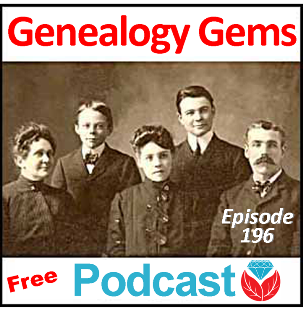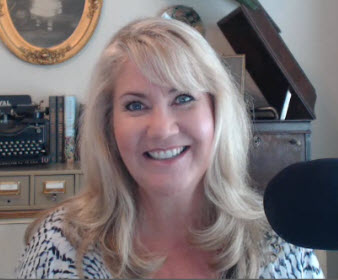How to Find Original Manuscripts with ArchiveGrid
Original manuscript records may reveal genealogical gems about your ancestors. Find these old records in archives around the country using this little-known, free online tool: ArchiveGrid.
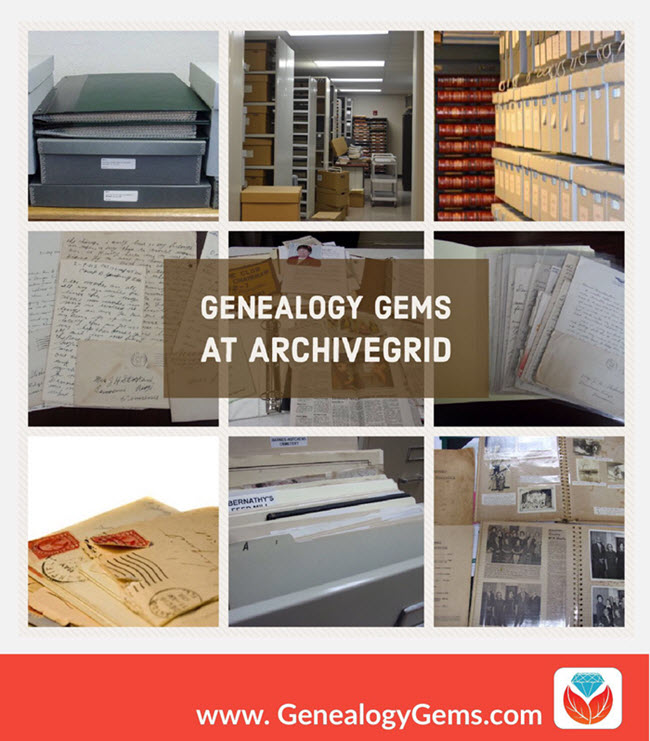
Manuscript records such as old diaries, letters, vital record collections, military documents, church registers, store ledgers, school and even business records can be genealogical gems. But finding original manuscript collections in archives and libraries can be difficult. Which archive has it? What’s the collection called? How can you access it?
ArchiveGrid can help
A little-known free website can help you locate old documents and manuscript items available in over 1,500 different archival collections. It’s called ArchiveGrid, and it currently includes close to 5 million archival item entries!
ArchiveGrid is a companion website to WorldCat, the free online catalog of millions of library items from thousands of libraries. The difference is that ArchiveGrid focuses not on published items but (generally-speaking) on unpublished ones.
How to search ArchiveGrid
From the ArchiveGrid home page, you can do two types of searches:
Search for repositories in ArchiveGrid
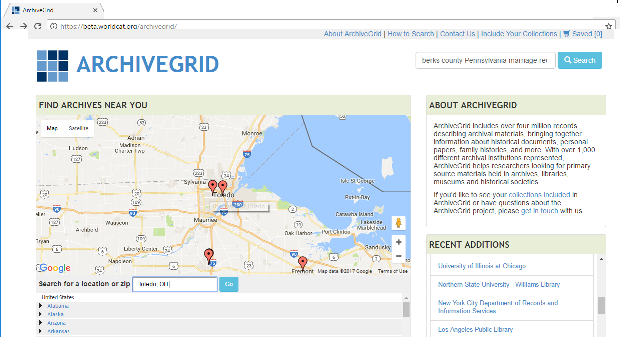
Use the map view, shown above on the left side, to identify archival collections that are near your ancestors’ home. These archives may hold materials related to your ancestors’ communities. Hover over the red markers to see the names of institutions. Click on them to find contact information and search their collections.
Search for specific manuscript items in ArchiveGrid
1. In the search box in the upper right part of the ArchiveGrid home page, enter search terms related to the manuscript items you hope to find, such as berks county pennsylvania marriage records. Then click Search. You’ll see a list of search results, such as these:
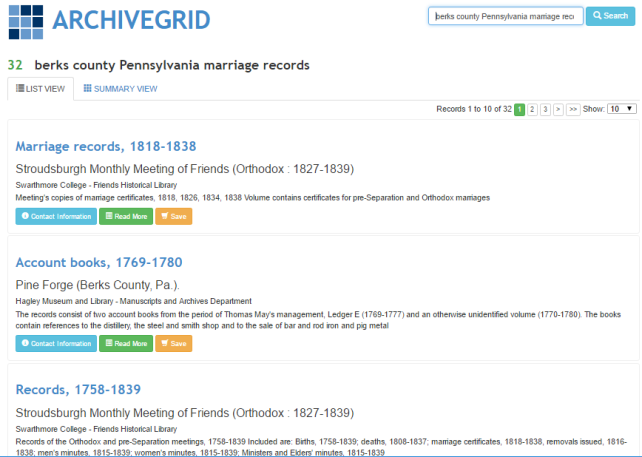
2. Browse search results. If you need to narrow or broaden your results, you can scroll to the bottom of the search results page and click the options you want.
3. Click on items of interest to read more about them. Here’s what a typical ArchiveGrid catalog entry looks like:
 The entry tells you more about the individual item. You may see when it was created, a physical description of it, who or what organization created it, and even brief historical background. You’ll see what repository holds it–and you can click under the name of that repository for its contact information. You may be able to order copies, visit to view the item in person, or hire a local researcher to do that for you.
The entry tells you more about the individual item. You may see when it was created, a physical description of it, who or what organization created it, and even brief historical background. You’ll see what repository holds it–and you can click under the name of that repository for its contact information. You may be able to order copies, visit to view the item in person, or hire a local researcher to do that for you.
As you can see, a sidebar to the right of this catalog entry says More Like This, with categories like people, places, groups, or topics. These links point to additional catalog items that are related in some way to the one you’re looking at—it’s something like browsing the stacks by topic at a library. (You can also sort all your search results this way from the main list of search results by clicking on Summary View.)
Now that the Family History Library is discontinuing its microfilm lending program, you may find yourself increasingly searching for original manuscript items that aren’t available online. And now that you know how to use ArchiveGrid, you may find yourself wanting to seek out these genealogical gems even more!
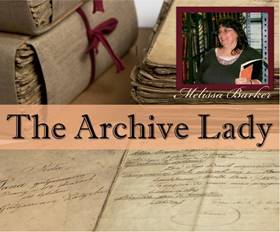 Learn More About Original Records
Learn More About Original Records
Learn more about finding and using original records from our new regular contributor on the Genealogy Gems podcasts: “The Archive Lady” Melissa Barker. Hear a full-length interview with her in the free Genealogy Gems Podcast episode #205. Genealogy Gems Premium website members can hear even more from her on finding and using original records in the Genealogy Gems Premium Podcast episode #149.
Photos used in the collage in this post are courtesy of Melissa Barker.
Episode 196
The Genealogy Gems Podcast
Episode 196
with Lisa Louise Cooke
In this episode, expert Kate Eakman from Legacy Tree Genealogists joins us with some tips for those starting to trace their Irish ancestors into Ireland. She shares some great websites for Irish research and places to look for that elusive Irish home county;and an exclusive coupon code for anyone who could use some expert help on a tough research problem.
Listen now – click the player below
In this episode, expert Kate Eakman from Legacy Tree Genealogists joins us with some tips for those starting to trace their Irish ancestors into Ireland. She shares some great websites for Irish research and places to look for that elusive Irish home county;and an exclusive coupon code for anyone who could use some expert help on a tough research problem.
Additional episode highlights:
- Gems listeners respond with strong opinions on sharing gossip about our ancestors;
- Genealogy Gems Book Club surprises: a past featured author has a new book out?and something different for the new Book Club pick;
- Mark your calendars and make some plans for big conferences in 2017;
- Organize your DNA test results and matches to help you get the most out of them, now and in the future.
BOOK CLUB NEWS: NEW FROM NATHAN DYLAN GOODWIN
British author Nathan Dylan Goodwin, featured in the past on the Genealogy Gems Book Club with his novel The Lost Ancestor has a NEW novel out in same forensic genealogy mystery series.
The Spyglass File: Hero Morton Farrier is back, and he’s on the trail of his client’s newly-discovered biological family. That trail leads to the fascinating story of a young woman who provides valuable but secret service during World War II?and who unknowingly became an entry in the mysterious Spyglass File. The connection is still so dangerous that Morton’s going to have bad guys after him again, and he may or may not be kidnapped right before he’s supposed to marry the lovely Juliette. Meanwhile, you’ll find him anguishing over the continuing mystery of his own biological roots?a story that unfolds just a little more in this new book.
MAILBOX: School Records Suggestion
Responding to Genealogy Gems Podcast episode #194:
“For those that have these old school records, consider donating them (even a digitized image) to the school from whence they originated. I shared class photos taken in the 1940s with my parents’ grade schools. The school was so appreciative! I hope another researcher down the road benefits from the pictures as well.” – Laura
MAILBOX: Passing on the Gossip
Blog post with Jennifer’s letter, my response, and several more comments
Here’s a link to a post about the stamp pendant Jennifer sent me
Lisa Louise Cooke uses and recommends RootsMagic family history software. From within RootsMagic, you can search historical records on FamilySearch.org, Findmypast.com and MyHeritage.com. In the works: RootsMagic will be fully integrated with Ancestry.com, too: you’ll be able to sync your RootsMagic trees with your Ancestry.com trees and search records on the site.
 Keep your family history research, photos, tree software files, videos and all other computer files safely backed up with Backblaze, the official cloud-based computer backup system for Lisa Louise Cooke’s Genealogy Gems. Learn more at http://www.backblaze.com/Lisa.
Keep your family history research, photos, tree software files, videos and all other computer files safely backed up with Backblaze, the official cloud-based computer backup system for Lisa Louise Cooke’s Genealogy Gems. Learn more at http://www.backblaze.com/Lisa.
INTERVIEW: Kate Eakman and Getting Started in Irish Genealogy
GENEALOGY GEMS EXCLUSIVE OFFER: Go to www.legacytree.com/genealogygems and use coupon code SAVE100 to save $100 on your purchase of research services.
Legacy Tree Genealogist specialist Kate Eakman shares tips about getting started in Irish genealogy. Here are the highlights:
Q: Where would you recommend the hobbyist start their Irish search?
A: Not a lot of Irish records are available online for free. Top sites for Irish records include: FamilySearch.org (click here for their Ireland landing page), National Archives of Ireland, Irishgenealogy.ie and Findmypast.com (click here for their Ireland page).
Q: What does a researcher need to know before crossing the pond?
A: Where the person was born in Ireland. The county. Find out if they were Protestant or Catholic. Click here for an interactive map of Irish counties, including those of Northern Ireland.
Q: Where do you recommend they look for that info in the U.S. crossing the pond?
A: Death records, marriage records, church records (keep an eye on extended family), passenger lists, naturalization papers. Keep an eye out for extended family members who may have come from the same place. Be aware of traditional Irish naming conventions and patterns.
Q: At what point in the Irish research process do hobbyists usually get stuck?
A: Common names regularly recycled, so it can be tough to sort out who is who. Also, a huge fire at the Public Records Office in Dublin in 1922 destroyed the bulk of government records. Click here for a description of what was lost and what surviving fragments are coming soon to Findmypast.com.
Q: How does it work to work with a professional genealogist at Legacy Tree Genealogists?
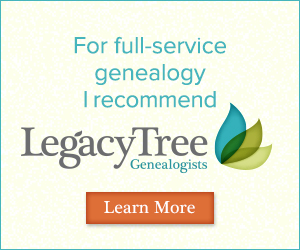 A: Here’s the process. A manager calls or emails the client to discuss their needs and parameters. They identify the goals and determine what the client already knows. A goal is settled on and then a researcher is assigned to the client. A written report of the research conducted is provided.
A: Here’s the process. A manager calls or emails the client to discuss their needs and parameters. They identify the goals and determine what the client already knows. A goal is settled on and then a researcher is assigned to the client. A written report of the research conducted is provided.
GENEALOGY GEMS EXCLUSIVE OFFER: Go to www.legacytree.com/genealogygems and use coupon code SAVE100 to save $100 on your purchase of research services.
The Legacy Tree Discovery package provides for 3.5 hours of preliminary analysis and research recommendations. It’s a great way to get started if you’ve hit a brick wall in your research and could use some expert guidance. Click here to learn more.
 This episode is sponsored by MyHeritage.com. the place to make connections with relatives overseas, particularly with those who may still live in your ancestral homeland. Click here to see what MyHeritage can do for you: it’s free to get started.
This episode is sponsored by MyHeritage.com. the place to make connections with relatives overseas, particularly with those who may still live in your ancestral homeland. Click here to see what MyHeritage can do for you: it’s free to get started.
DNA GEM with Your DNA Guide buy bv medication Diahan Southard: Organizing Your DNA
I can tell whose turn it is to unload the dishwasher by the state of the silverware drawer. If either of the boys have done it (ages 13 and 11), the forks are haphazardly in a jumble and the spoon stack has overflowed into the knife section, and the measuring spoons are nowhere to be found. If, on the other hand, it was my daughter (age 8), everything is perfectly in order. Not only are all the forks where they belong, but the small forks and the large forks have been separated into their own piles and the measuring spoons are nestled neatly in size order.
Regardless of the state of your own silverware drawer, it is clear that most of us need some sort of direction when it comes to organizing our DNA test results. Organizing your matches entails more than just lining them up into nice categories like Mom’s side vs. Dad’s side, or known connections vs. unknown connections. Organizing your results involves making a plan for their use. Good organization for your test results can help you reveal or refine your genealogical goals, and help determine your next steps.
The very first step is to download your raw data from your testing company and store it somewhere on your own computer. I have instructions on my website if you need help.
Once that is complete, we can get to the match list. One common situation for those of you who have several generations of ancestors in the United States, you may have some ancestors that seem to have produced a lot of descendants who have caught the DNA testing vision. This can be like your overflowing spoon stack, and it may be obscuring some valuable matches. But identifying and putting all of those known matches in their proper context can help you realize these abundant matches may lead to clues about the descendant lines of your known ancestral couple that you were not aware of. In my Organizing Your DNA Matches quick sheet I outline a process for drawing out the genetic and genealogical relationships of these known connections to better understand their relationship to each other and to you. It is then easier to verify that your genetic connection is aligned with your known genealogical paper trail and spot areas that might need more research.
This same idea of plotting the relationships of your matches to each other can also be employed as you are looking to break down a brick wall in your family tree, or even in cases of adoption. The key to identifying unknowns is determining the relationships of your matches to each other, so you can better see where you might fit in.
Another helpful tool is a trick I learned from our very own Lisa Louise Cooke, and that is Google Earth. Have you ever tried to use Google Earth to help you in your genetic genealogy? Remember that the common ancestor between you and your match has three things that connect you to them: their genetics, surnames, and locations. We know the genetics is working because they are showing up on your match list. But often times you cannot see a shared surname among your matches. However, by plotting their locations in the free Google Earth, kind of like separating the big forks from the little forks, you might be able to recognize a shared location that would identify which line you should investigate for a shared connection.
So, what are you waiting for? Line up those spoons and separate the big forks from the little forks, your organizing efforts may just reveal a family of measuring Spoons, all lined up and waiting to be added to your family history.
GENEALOGY GEMS BOOK CLUB: Sarah A. Chrisman

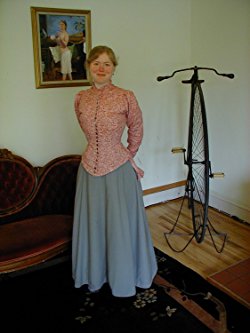
Author spotlight: Sarah A. Chrisman, living icon of the Victorian age.
Sarah and her husband Gabriel live like it’s about 1889. They wear Victorian-style clothing and use a wood-burning stove and antique ice box. Sarah wears a corset day and night Gabriel wears 19th century glasses. No TV, no cell phones?and Sarah isn’t even a licensed driver.
For this Book Club, you can take your pick of Sarah’s books! Which would you like to read?
This Victorian Life: Modern Adventures in Nineteenth-Century Culture, Cooking, Fashion and Technologies, a memoir Sarah’s everyday life. The Book Club interview in December will focus mainly on this book.
Victorian Secrets: What a Corset Taught Me about the Past, the Present and Myself;
True Ladies and Proper Gentlemen: Victorian Etiquette for Modern Day Mothers and Fathers, Husbands and Wives, Boys and Girls, Teachers and Students, and More;
First Wheel in Town: A Victorian Cycling Club Romance. This is from her series of light-hearted historical fiction set in an era she knows well!
In honor of the Book Club theme, Genealogy Gems is going Victorian! From now through the end of the year, you’ll find Victorian-inspired crafts, recipes, décor, fashions and more on our Instagram and Pinterest sites, which of course we’ll link to regularly from the Genealogy Gems website, newsletter, podcast show notes and Facebook page. Nobody does sumptuous holiday traditions quite like the Victorians, and we look forward to celebrating that.
BONUS CONTENT for Genealogy Gems App Users
 If you’re listening through the Genealogy Gems app, your bonus content for this episode is a PDF with instructions on accessing the new free Guild of One-Name databases on FamilySearch.org.
If you’re listening through the Genealogy Gems app, your bonus content for this episode is a PDF with instructions on accessing the new free Guild of One-Name databases on FamilySearch.org.
The Genealogy Gems app is FREE in Google Play and is only $2.99 for Windows, iPhone and iPad users.
Receive our FREE Genealogy Gems Newsletter:
Subscribe to the Genealogy Gems newsletter to receive a free weekly e-mail newsletter, with tips, inspiration and money-saving deals.
Disclosure: This article contains affiliate links and Genealogy Gems will be compensated if you make a purchase after clicking on these links (at no additional cost to you). Thank you for supporting Genealogy Gems!
5 Reason You MUST Look at Original Records
Show Notes: When you find family history information online you MUST make every effort to find the original genealogy record so that your family tree will be accurate! There are 5 reasons to find original records. I’ll explain what they are, and what to look for so that you get the most information possible for your family tree.
If you’re a genealogy beginner, this video will help you avoid a lot of problems. And if you’re an advanced genealogist, now is the time to fix things.
Watch the Video
Show Notes
Downloadable ad-free Show Notes handout for Premium Members.
#1 Many online records are simply way too vague.
Records come in many forms. Many genealogy websites consider that each name that appears on a document is a “record” when they’re counting records. So, when you hear that 10 million records have been added to a website, it doesn’t necessarily mean that 10 million genealogical documents have been added. It oftentimes means that that’s the number of names that they’ve added.
One document could have a lot of names. In the case of a death certificate, it could have the name of the deceased, the name of the spouse, the name of the informant, and the names of the parents. Each one of those gets counted as a record.
Recently, MyHeritage announced they’ve added 78 million new records to their website. However, many of these records are simply transcriptions, they’re extracting the information from whatever the original source was. That information becomes searchable, and that’s terrific because they are great clues. So, sometimes when you go and look at the records themselves, it turns out that record really is just a transcription. There is no digital record to look at.
Sometimes the website doesn’t even tell you what the original record was. There will be clues, though. You can use those clues and run a search on those words. So, if it talks about a particular location, or type of record, or the name of the record, you could start searching online and find out where are those original records are actually held. Sometimes they are on another genealogy website. But a lot of times, and I’ve seen this more recently, they are publicly available records, oftentimes from governmental agencies. Very recently, we’ve been seeing more recent records that are just selected text. They may be records for people who just passed away a year or two ago.
There are a wide range of places where these types of records can come from. But if that genealogy website got its hands on the record, chances are you could too. And it’s really important to do that.
#2 What’s important to you might not have been prioritized for indexing.
The indexer is a person, or perhaps even an artificial intelligence machine, who has gone through the documents and extracted information and provided it in text form. Sometimes when you search on a genealogy website, all you’re getting is just that typed text, that transcription, of some of the key data from the original document.
I’ll tell you about one example in my family. I was looking at a 2x great grandmother back in Germany. Her name was Louise Leckzyk. She’s listed as Louise Nikolowski in the Ancestry record hint. Technically, that’s true, she was Louise Nikolowski at the time of the birth of her child. But if you pull up the original record, what you discover is she’s not listed as Louise Nikolowski on the record. She’s listed with her maiden name, which was usually the case in those old German church records. So that’s huge. We’ve talked about how challenging it can be to find maiden names here on the Genealogy Gems channel. So, we don’t want to miss any opportunity to get one. But if we had taken this record hint at face value, and just extracted that information, put it in our database, or attached it to our online family tree, and never looked at the original document, we would have completely missed her maiden name. And that maiden name is the key to finding the next generation, her parents.
#3 Not all information on a record is indexed.
It’s very common for large portions of information on a document not to be indexed. Here’s the reason for that: Indexing costs money. When a genealogy company takes a look at a new record collection they have some hard decisions to make. They have to decide which fields of information will be included in the indexing. Oftentimes, there will be several columns, as in a church record or a census record. The 1950 census was an example of this. There’s so much data that the company has to look at that and say, what do we think would be of the most value to our users? They then index those fields. They’ve got to pay to not only have them indexed, but potentially also reviewed human eyes, or AI. That all costs money.
So, there will inevitably be information that gets left off the index. That means that when you search the website you’re going to see the record result, and it can give you the impression that that is the complete record. But very often, it’s not the complete record. Tracking down and taking a look at the original digital scan of the record is the only way to know.
It’s possible that the records have not been digitally scanned. In the case of public government records, that information may have been typed into a database, not extracted from a digital image. There may not be a digital scanned image. It may be very possible that the only original is sitting in a courthouse or church basement somewhere. It’s also possible that the digital images are only available on a subscription website that you don’t subscribe to.
We need to do our best to try to track down the original document and take a look at it to see if there’s anything else that’s of value to us in our research that the indexers or the company just didn’t pick up on or didn’t spend the money to index.
#4 Different websites potentially have different digital scans of the same record.
Websites sometimes collaborate on acquiring and indexing records. In those cases, they might be working with the same digital images. But oftentimes, they create their own digital scans. That means that a record may be darker or lighter, or sharper or blurrier from one website to the next. So while you found the record on one website, another might have a copy that’s much easier to read.
Digital scanning has also come a long way over the years. Many genealogy sites now are looking at some of the earlier scans they did. They’re realizing that some are pretty low quality by today’s standards. They might determine that it’s worth going back and rescanning the record collection. This happened with some of the earliest census records that were digitized many years ago. It makes a lot of sense, because a lot of time has passed, and technology has certainly changed.
So even though you found information many years ago, it might be worth taking a second look if you have any questions about what’s on that document. You may find that that record is actually a newly digitized image on the same website, or you might find that it’s also available somewhere else.
A lot of the partnerships out there are with FamilySearch which is free. So, while you may have a paid subscription to a site like Ancestry or MyHeritage, if there’s anything that you’re questionable on, or you didn’t actually see the original document from one of those paid websites, head to FamilySearch.org. Run a search and see if they happen to have the digitized images. There’s a good chance they might, and it’s worth taking a look.
Sometimes the genealogy website will have tools that allow you to get a better look at the digitized document. Ancestry is a great example of this. On the digitized image page click the tool icon to open the Tools menu. One of my favorite tools is “Invert colors”. Click that button, and it will turn it into a negative image. Sometimes this allows words to pop out in a way that they were not as clearly visible in the normal view.
I downloaded a digital scan from a website several years ago, and it was hard to decipher. I did some searching and was able to find a clearer copy on another website.
#5 You can verify that the words were indexed accurately.
Reviewing a scan of the entire document provides you with a lot of examples of the handwriting of the person who made the entry. If you have any doubt about words or spelling, making comparisons with other entries can be extremely helpful.
When I first looked at a baptismal record of my 2x great grandmother’s son, I thought her surname was Lekcyzk. However, after seeing a different digital scan, I started to question that. Having the original record allows me to review the handwriting of the person who wrote these records. Comparing the handwriting of other entries on the page helped me determine that the swish at the top is the dotting of an eye that just had a bit more flourish. I also reconfirmed that the Z in the name is definitely a Z by comparing it to other Zs on the page.
Bonus Reason: You may have missed the second page.
Some records have more than one page, and it’s easy to miss them. If the indexer took information primarily off of the first page, it may not be obvious when you look at that page, that in fact, it’s a two-page (or more) document. More pages potentially means more valuable information!
It’s also possible that if you downloaded a document years ago when you first started doing genealogy, you might have missed the additional pages. Now that you’re a more experienced researcher, it would be worth going back and looking at particular types of records that are prone to having second pages. Examples of this are:
- census records,
- passenger list,
- passport records,
- criminal records,
- and probate records.
If you have single page records that fall in one of these categories saved to your computer, you might want to go back and do another search for them and check the images that come before and after that page to see if there are more gems to be found.
I hope I’ve convinced you to always make the effort to obtain and review original records for the information that you find while doing genealogy research online.
I’ll bet there’s even more reasons to do this, so I’m counting on you. Please leave a comment and let me know what you’ve found following these 5 reasons, and any additional reasons that you have.
Resources
Downloadable ad-free Show Notes handout for Premium Members.

